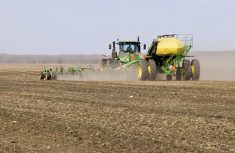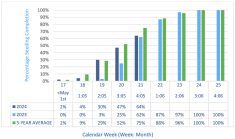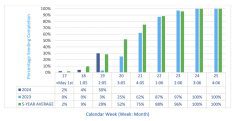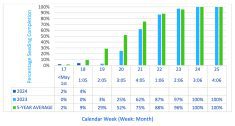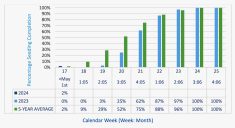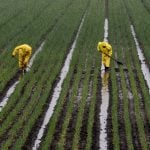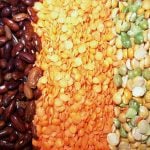Southwest Region
Very hot daytime temperatures this week, up to 35 C; daily averages around 21 C. Minimum overnight temperatures were down to 7 to 12 C. Lack of rain is still stressing crops. Rain on the weekend and Monday fell throughout the region but amounts are variable, most of the region had between 10 to 45 mm. This rain came too late for cereals, but will help other crops and pastures. Any rainfall has benefitted crop quality and bushel weights in canola, corn, soybean, and sunflowers.
Winter wheat and fall rye harvest are underway in some areas. Yields look to be average to slightly below average with good quality. Early seeded spring cereals are ripening and producers have started pre-harvest. The majority of cereals will be close to pre-harvest by the end of the week. Some early seeded barley and oats have been harvested with yields average to below average.
Read Also
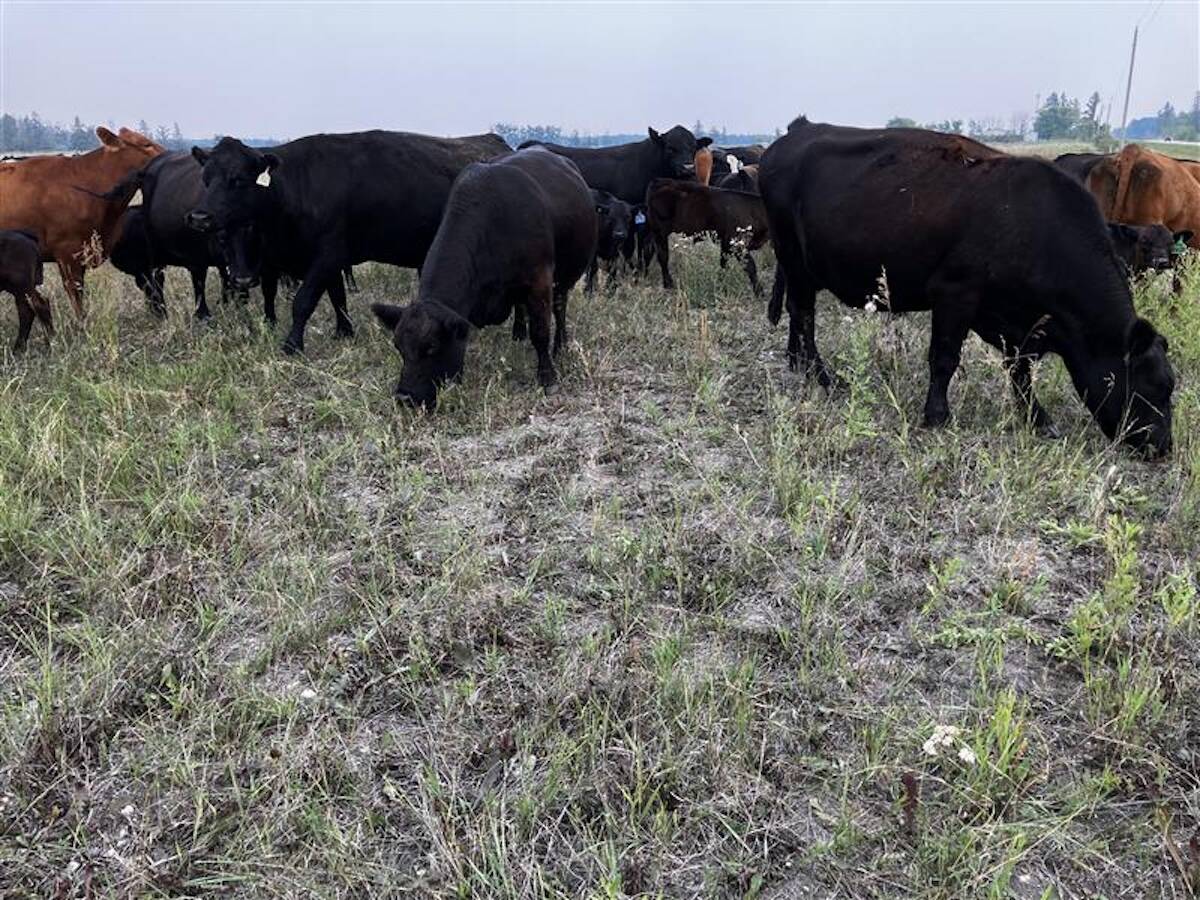
Drought year continues to develop for beef producers
Dry pasture and poor forage in parts of Manitoba have cemented 2025 as another year of support measures and drought management struggles for beef and other grazing sectors.
Canola has started to ripen, swathing has been started in some areas but later seeded or reseeded canola is moving past flowering now and showing some moisture stress. Several producers are going to straight-cut canola this year due to uneven crops, and will require a pre-harvest desiccant. Smoke and hazy conditions have helped canola extend flowering period. Bertha armyworm and diamondback moth levels look to be low at this time. No major disease problems to report. There is some grasshopper damage to the crop.
Soybeans are in the late R5 (seed set) to R6 (early pod filling) stage. The crop looks to have handled warm weather well, and many pods have 3 to 4 seeds per pod, but some fields are starting to show moisture stress and prematurely drying down but this week. Grasshopper damage has been localized.
Farmers have been harvesting peas and yields look to be average with good quality. Some forage peas are still green.
Flax fields are now ripening and drying down. There are minimal disease or insect issues. Late season weeds are a major problem in some fields. Corn silks are drying up and the cobs are starting to swell. Recent large rains and heat are favoring timely developments. Sunflowers are starting to enter R5.8 (full flower – later stage), though some are still in the R5.1 stage.
Most producers are faced with poor pasture conditions. Recent rains may help some areas but in general, most grasses have shut down growth for this year. Shortages of feed remain a problem and extremely high prices are making it difficult for producers to secure feed for the winter. Producers are looking to alternate feed sources like straw, but even those prices have increased. Producers are doing a second cut in some areas and yields look to be below average with good quality. Cereal silage is being made and yields so far look to be average. Corn silage will benefit from recent rains. Dugouts and water sources are drying up and reports of several producers hauling water.
Northwest Region
A break in the high temperatures this week was welcomed for a few days, along with higher humidity and isolated thundershowers. Most parts of the region received at least some rainfall, although smaller amounts in areas that could benefit the most. Minitonas/Birch River received the most precipitation with 23 mm accumulated. Water sources and soil moisture conditions across the entire region continue to remain very dry.
Field pea harvest is underway across the region. Yields are reportedly lower with the average about 35 to 40 bu/ac range across most of the region, and a little higher near Grandview with 45 bu/ac average. Averages may change as harvest continues. Desiccation also continues as stages are reached.
Desiccation of spring wheat across most of the region is occurring as stages are reached, with the exception of The Pas where most wheat is at soft dough. Harvest has begun in the southern portion of the region with a wide range in yield and quality, although just starting and still early to base an average. Oats and barley continue to ripen.
Canola for most of the region is podded and ripening. Canola in The Pas is 90% podded, with the remaining in the flowering stage. Sunscald has become evident due to recent high temperatures and UV indices. About half of the canola in the region is rated as good, with the remainder rated as fair and a small percentage in poor condition.
Soybeans across the region are at R3 to R4, with the southern part of the region in the more advanced growth stage. Soybeans are rated as good condition so far, with some regions receiving timely rains and will help the crop.
Insect monitoring has wrapped up and accumulated trap counts remained below concern for Bertha Armyworm and diamondback it is suggested to continue monitoring. Lygus bugs have become a concern in Swan River region where counts exceeded threshold and control was warranted in younger canola; flea beetles have also seen high numbers again. Grasshoppers also remain a large concern across most of the region.
Monday’s rainfall was very welcome across the area, especially for re- growth on pastures and hayfields, although the amounts received have not been significant and there are areas that have been missing the rains.
Producers continue to bale up straw, ditches as well as low-lying areas of sloughs and lakeshores to secure additional feed. Hay yields are being reported at 15 to 20% of normal in the areas severely affected with dry conditions with higher yields on newer, well- fertilized stands that received more moisture. Harvesting of annual crops for feeds is ongoing. In the western side of the region, producers are taking a second cut prior to August 15th in respecting the critical fall harvest period to reduce the likelihood of winterkill in alfalfa where sufficient regrowth occurred. Cobs are forming on corn silage fields with producers worried on how they will develop without adequate soil moisture.
Feed supplementation on some pastures is occurring with creep feeding for calves and with the use of protein tubs. Numerous pastures have gone dormant, herds have been sorted, and some sent to cull markets. Water supplies remain low and water is being hauled to livestock. Grasshoppers remain a concern across the entire area.
Central Region
After a week of continued warm and dry conditions, a thunderstorm system moved across the region on Monday bringing significant precipitation to all parts of the region. Precipitation amounts varied from 10 mm in Manitou to 50 mm in areas located along the international border, but most areas received 15 to 25 mm. Some hail reported in the Altona area but damage considered light at this point while affected fields are assessed. The rain was rapidly absorbed by the dry soils even in areas with higher precipitation.
Soil moisture is improved from poor to good for areas with recent rainfall, which will benefit late maturing crops most. Harvest operations will be delayed slightly, but should resume soon with a sunny and warm forecast.
Winter cereals are ripe with only patches in fields still ripening in few cases. Harvest of perennial ryegrass and fall rye is wrapping up with more last fields being swathed ahead of harvest. Yield reports for rye is in the 60 to 70 bu/ac acre range with good quality grain reported. Wheat, oats and barley are ripening rapidly. Spring wheat harvest is just beginning west of the escarpment while in the Red River Valley about 15 to 30% is done in the Altona to Carman areas. The Plum Coulee area toward Winnipeg is most advanced with some growers have their wheat harvest already done. Yields vary widely according to soil type and moisture conditions. Yields are reported from 20 to 70 bu/ac, with many averaging near 40 bu/acre with good quality. Protein levels are reported between 15 and 16% on CWRS wheat.
Barley harvest is also underway with about 20 to 25% done and yield reports range from 50 to 100 bu/ac but averaging closer to 70 bu/acre. Whatever straw is available is being baled quickly with lots of trucks on the road moving bales. Oat harvest started with 10 to 20% done and yields vary widely from 40 to 100 bu/ac, again dependent on soil type and moisture conditions.
Some pre-harvest products for perennial weed control and harvest management are being applied to some fields but many are drying down without.
Field peas harvest progressed well with about 80% completed. Yield reports are in the 20 to 60 bu/ac range. Local cattle producers in need are baling some pea straw.
Canola fields are done flowering with some almost ripe in the more advanced fields. No harvest reported but early fields are being swathed. Yield expectations vary greatly as some fields will be near normal having good growth and others very short, thin and very poor pod development. Grasshopper feeding requiring control measures being applied to edge of fields west of the escarpment. Heavy populations of aphids noticed on some canola fields as they mature requiring control measures to stressed crops. Flax fields are short in stature, mostly in the boll stage and starting to turn.
Soybean fields are beginning seed to full seed (R5 to R6). Recent precipitation should benefit this late maturing crop while still in the seed filling stage. Field beans are generally still looking fairly good and should benefit from the recent rain.
Sunflowers are a late maturing warm-season crop can tolerate warmer temperatures but stands are shorter than normal. This last rain should benefit seed filling. The lack of moisture has limited growth and development of those fields. Staging is in the reproductive stage ranging from mid-flowering to flowering complete (R.5 to R6).
Corn growth varies with moisture conditions. Most fields have tasselled and ear is developing but growth is slow with the poor moisture conditions. The recent precipitation should benefit corn crops but yield potential has already been affected by the prolonged dry conditions. Many fields in the Red River Valley in particular showed evidence of severe moisture deficit with leaf rolling symptoms and varying plant height across fields. A number of cornfields in the Carman to Morden area have been written- off, and may and are offered as cattle feed. Producers are cautioned to test for nitrates before grazing, ensiling or baling those fields.
Potatoes will benefit from the rain and are supplemented with irrigation where water is available. No late blight spores were detected and risk forecast is low. High aphid numbers were being trapped, and may increase as other crops mature. European corn borer numbers have declined substantially and monitoring is ending.
Hot and dry conditions have caused crop, pasture and forage conditions to deteriorate further over the last week. Adult grasshoppers are actively feeding in pasture, hay fields and crops that are greener. Very little second cut alfalfa was or will be harvested, as growth was minimal. Most hay fields and pastures have stopped growing and have turned brown. Some cattle are being supplemented on pasture where forage growth is lacking. Water availability is still sufficient but surface supply is getting poorer in quantity and quality. Many pastures only have forage to graze in the bush or low-lying areas where moisture was better.
Eastern Region
Rainfall accumulation across the region ranged from 7 to greater than 50 mm. Almost all of this rainfall arrived as thunderstorms and general rain showers on Monday and overnight into Tuesday of this week. Up until these rainfall events, most reporting districts continued to experience warm to hot and dry weather. Even though cereal harvest had to pause, grain producers were generally pleased with the rainfall but those who received an inch or less hoped that more was on its way. Dairy and beef producers were not expecting much benefit in hay and pasture conditions given the time of year but hoped that the rainfall would raise river levels and at least partially refill dugouts. The recent rainfall is expected to help preserve yield potential in warm season crops like soybean, corn and sunflower and support continued seed filling in canola.
Winter wheat and fall rye harvest made good progress with many producers done or almost done. Winter wheat yield reports varied from 50 to 80 bu/ac on whole field basis with light soil areas doing as low as 30 bu/acre. Good seed quality and test weight were noted. Fall rye yields were highly variable in fields in correlation with soil types. Yields ranging from 50 to 90 bu/ac across fields with whole fields averaging out in that 70 to 80 bu/ac range.
Spring wheat harvest began in earnest last week but limited progress was made with only 5 to 10% of acres harvested. Producers were finding that field that looked yield ready might still have seed moistures testing 20% or more. Some drying of wheat was being done to push harvest along and preserve quality. Initial yield reports ranged from 50 to 70 bu/ac with growers hoping that most spring stands had enough moisture to complete filling in time. Initial quality reports indicated low or zero fusarium and good bushel weights.
Oat harvesting continued last week with most producers disappointed with results. Yield reports ranged from 50 to 100 bu/ac with 70 bu/ac averages and light bushel weights commonly reported. Oat harvest progress amongst producers ranged from about 50% done to complete. Oats tended to simply dry out rather than naturally mature in the hot dry weather. Some challenges with stands that look harvest ready still have high seed moistures also occurred. All spring cereal harvesting is on pause given the recent rainfall.
Canola continued pod filing with many fields also ripening. A limited amount of swathing of early seeded crop took place last week. Recent rainfall is expected to support seed filling and help preserve seed size but overall yield levels are still expected to range from average to below average across the region. A limited amount of insecticide applications to control late season flea beetle and diamondback larvae damage occurred last week but is expected to tail off as the crop ripens and pre-harvest intervals prevent further applications.
Flax crops are filling bolls, but bolls appear to be lighter and most crops continued to look poor. Many fields contain completely dried out plants with shrunken seeds in bolls mixed with plants that are still filling while displaying signs of severe moisture stress. While the recent rain will help preserve some yield, it has come too late for many flax fields.
Soybeans continued to demonstrate widespread leaf flipping and some wilting as drought stress symptoms last week. Recent rainfall is expected to help with preserving seed size and seed number per pod and may increase the likelihood that more recently formed small pods will fill instead of drying out. Overall, producers and agronomists had been generally impressed with how the crop has tolerated the dry conditions but acknowledged that rain was needed immediately. A limited number of fields with spider mites were noted last week. In a few cases, damage by the spider mites exceeded threshold and insecticide applications across whole fields or parts of fields or field perimeters occurred. Concern is expected to subside as the crop moves fully into the R6 growth stage.
Corn crops finished silking last week, and crops continued to fill. Cobs examined appeared to have seed set right to tips, but up until recent rainfall, crops continued to demonstrate widespread drought symptoms with leaf curling and bottom leaves firing off.
Sunflowers ranged from R5.9 flowering stage with the majority of the crop at the early R6 seed filling stage last week. Overall crop condition looked good and it is expected recent rainfall will support seed filling and help preserve yield.
Hay and pasture conditions continued to worsen. Beef producers continued with second cut with lots of variability in progress from producer to producer and many acres not having a second cut because of lack of growth. Yields continued to be in that 10 to under 25% of normal range. Cutting of oat and barley fields for silage or greenfeed continued and baling of straw was widespread. Pasture conditions remained very poor with supplementary or full feeding on pasture continuing. Cattle herds continued to be culled with animals being shipped to market. Recent rainfall is not expected to improve the hay and pasture situation significantly. Producers in areas that received higher rainfall amounts are hoping river and dugout levels rise. Livestock water availability is rated as adequate because producers have implemented a variety of measures to deal with the situation.
Interlake Region
Monday thundershowers provided some temperature relief in the northern Interlake, and rainfall of 10 to 25 mm fell between Moosehorn though Taylor’s Point to Arborg and south to Teulon. Harvest was delayed slightly, but extremely dry topsoils have absorbed all water, and cereal harvest will resume shortly. Fall rye harvest is complete, no yields reported.
Spring wheat, barley, and oat harvest continues, with yields below average for all crops. Wheat yields range from 25 to 70 bu/acre, averaging in the low between 35 to 40 bu/acre. Many crops have fewer spikelets than normal, and kernel size is smaller.
Oats are typically yielding 50 to 80 bu/ac in the south Interlake area; most oats is lightweight. Many oat crops were already cut and baled off for greenfeed. Barley has been yielding between 20 to 80 bu/ac, averaging mid-40’s.
Cereal straw is in high demand, and all straw is being dropped and baled behind combines and harvest progresses.
A high number of reseeded canola crops mean that canola ripening and swathing is delayed, but original crop is turning brown, and beginning seed colour change. Desiccation on variable crops will start towards the end of this week. Yields are anticipated to be between 5 to 10 bu/acre on poor stands, and may be better on rain-fed areas closer to Meadows. Swathing has started on a few scattered fields not intended as a straight-cut hybrid, over 90% of canola crops are expected to be direct-harvested. Some farmers are forced to spray for diamondback moth larvae, as levels have risen in the past five days.
Flax crops are suffering, and smaller less developed root systems are leaving bolls unfilled and shrivelled.
Soybeans, sunflowers, and corn crops are still green, but have stopped actively growing. All three crops remain much shorter than normal, with less anticipated yield. Rainfall did not arrive in significant quantities over the southern Interlake, and may have been too late in the northern districts to continue with soybean pod fill.
Sunflower crops are highly variable; some are quite short, while others appear in better condition with larger head size. Insecticide application on those crops has been limited, and farmers are hesitant to spend additional dollars on crop protection when yields are expected to be down.






